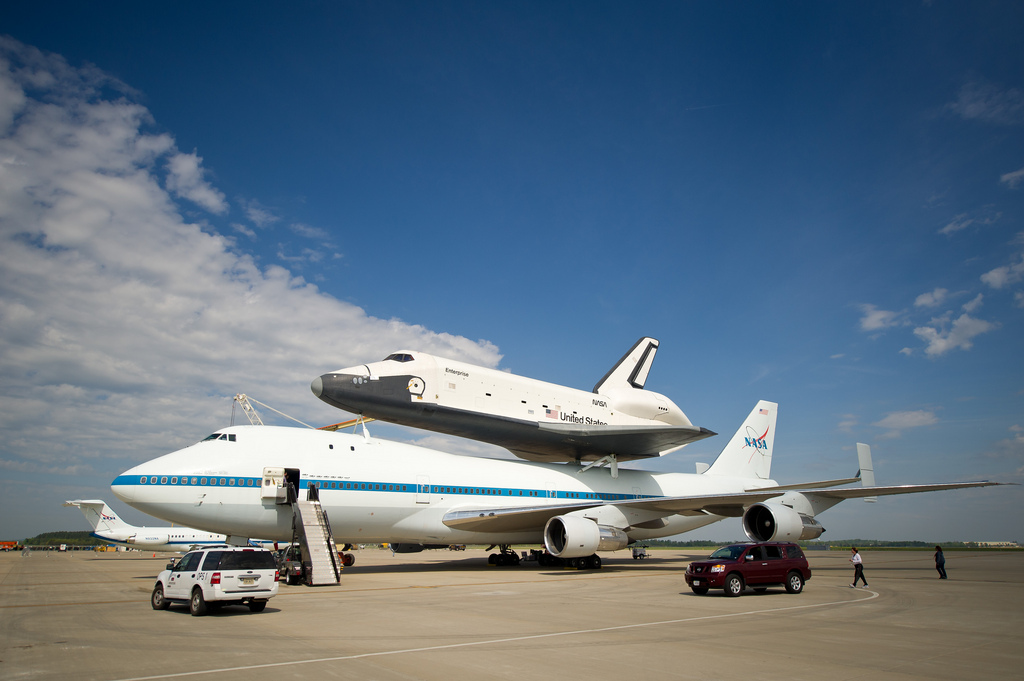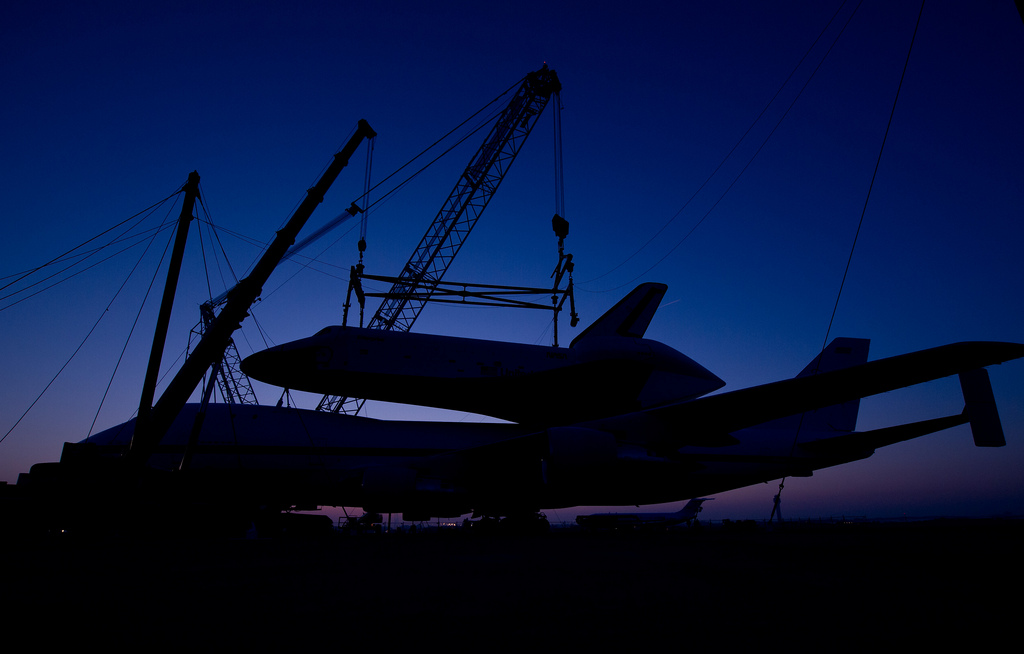Space Shuttle Enterprise's NYC Arrival Reset for Wednesday

NEW YORK — The countdown for space shuttle Enterprise's touchdown in New York is back on.
The prototype NASA orbiter, which never flew in space but was used for approach and landing tests in the late 1970s, will now take off from Washington, D.C., for the Big Apple on Wednesday (April 25), weather permitting. NASA officials will hold a final weather review Tuesday morning that, if it goes well, could clear Enterprise for a flight the next day between 9:30 a.m. and 11:30 a.m. EDT (1330 and 1530 GMT).
Later this summer, Enterprise will be transported by barge to New York's Intrepid Sea, Air and Space Museum, on the retired World War II aircraft carrier U.S.S. Intrepid, for its public display.
NASA's original test shuttle had been scheduled for delivery to John F. Kennedy (JFK) International Airport today (April 23) but concerns over the weather delayed its departure. NASA managers met this afternoon to review the forecasts and set the new date.
Enterprise had been on display in the Smithsonian National Air and Space Museum's Steven F. Udvar-Hazy Center in Chantilly, Va., since 2003, but was displaced when the space-flown shuttle Discovery arrived last Thursday. The next day, Enterprise was mounted atop the Shuttle Carrier Aircraft, a modified Boeing 747 jumbo jet, and has since sat at Washington Dulles International Airport waiting for sunny skies. [Photos: A Space Shuttle Called 'Enterprise']

Rain, rain, go away
NASA, in consultation with Intrepid officials, announced the flight delay on Friday. Local forecasts called for a low pressure system on the east coast to deliver low clouds and rain in both the Washington and New York areas, precluding the ferry flight begin until Wednesday (April 25) at the earliest.
Get the Space.com Newsletter
Breaking space news, the latest updates on rocket launches, skywatching events and more!
Over the weekend, rain did fall on Enterprise.
To protect against the showers, shuttle engineers installed makeshift "rain covers" over Enterprise's vent openings on Saturday. After a trip to the local hardware store, workers fabricated the covers out of foam board that they then covered in their hotel parking lot with aluminum sheeting, weather stripping and wood.
The covers will be removed before Enterprise departs for New York.
NASA stated that the decision to delay Enterprise's ferry was to ensure a safe flight for both the test orbiter and the carrier aircraft crew. At the speed they fly, raindrops can inflict damage on the shuttle's heat shield tiles, and due to weight constraints, the jet does not have the fuel reserves to maneuver around the storms.
NASA also hoped to fly Enterprise over some of New York City's famed landmarks, including low passes near the Statue of Liberty and the Intrepid museum, for photo opportunities. These flyovers however, were weather dependent.
27 years and counting
The last time Enterprise took to the air was on Nov. 18, 1985, when it arrived at Dulles Airport from the Kennedy Space Center in Florida to be donated to the Smithsonian. As with this upcoming flight, it was then mounted on the same aircraft that began its airborne service to NASA.
Before the space-worthy orbiters could fly and return from space, Enterprise flew a series of approach and landing test (ALT) flights in 1977 to verify the shuttle's handling as an unpowered glider when returning from space. Two pairs of two astronaut pilots each flew Enterprise to landings at Edwards Air Force Base in California after the orbiter was lofted to altitude by the Shuttle Carrier Aircraft NASA 905.
For this week's flight, Enterprise will fly without a crew — its own cockpit stripped of its instruments long ago — and will remain mounted to the 747 through the touchdown at JFK in front of an invited audience of 1,500 people.
On the ground, the air- and spacecraft will remain together until NASA can re-stage the large cranes it used to hoist Enterprise atop the jet in Washington to New York.
Enterprise will then wait in a JFK hangar until June, when it will loaded onto a barge and moved around Manhattan to the Intrepid. There, the orbiter will be craned onto the museum's flight deck for display.
The Intrepid's new "Space Shuttle Pavilion," a temporary climate-controlled steel-and-fabric structure, is targeted to open to the public in mid-July.
Visit shuttles.collectspace.com for continuing coverage of the delivery and display of NASA's retired space shuttles.
Follow collectSPACE on Facebook and Twitter @collectSPACE and editor Robert Pearlman @robertpearlman. Copyright 2012 collectSPACE.com. All rights reserved.
Join our Space Forums to keep talking space on the latest missions, night sky and more! And if you have a news tip, correction or comment, let us know at: community@space.com.

Robert Pearlman is a space historian, journalist and the founder and editor of collectSPACE.com, a daily news publication and community devoted to space history with a particular focus on how and where space exploration intersects with pop culture. Pearlman is also a contributing writer for Space.com and co-author of "Space Stations: The Art, Science, and Reality of Working in Space” published by Smithsonian Books in 2018.In 2009, he was inducted into the U.S. Space Camp Hall of Fame in Huntsville, Alabama. In 2021, he was honored by the American Astronautical Society with the Ordway Award for Sustained Excellence in Spaceflight History. In 2023, the National Space Club Florida Committee recognized Pearlman with the Kolcum News and Communications Award for excellence in telling the space story along the Space Coast and throughout the world.










